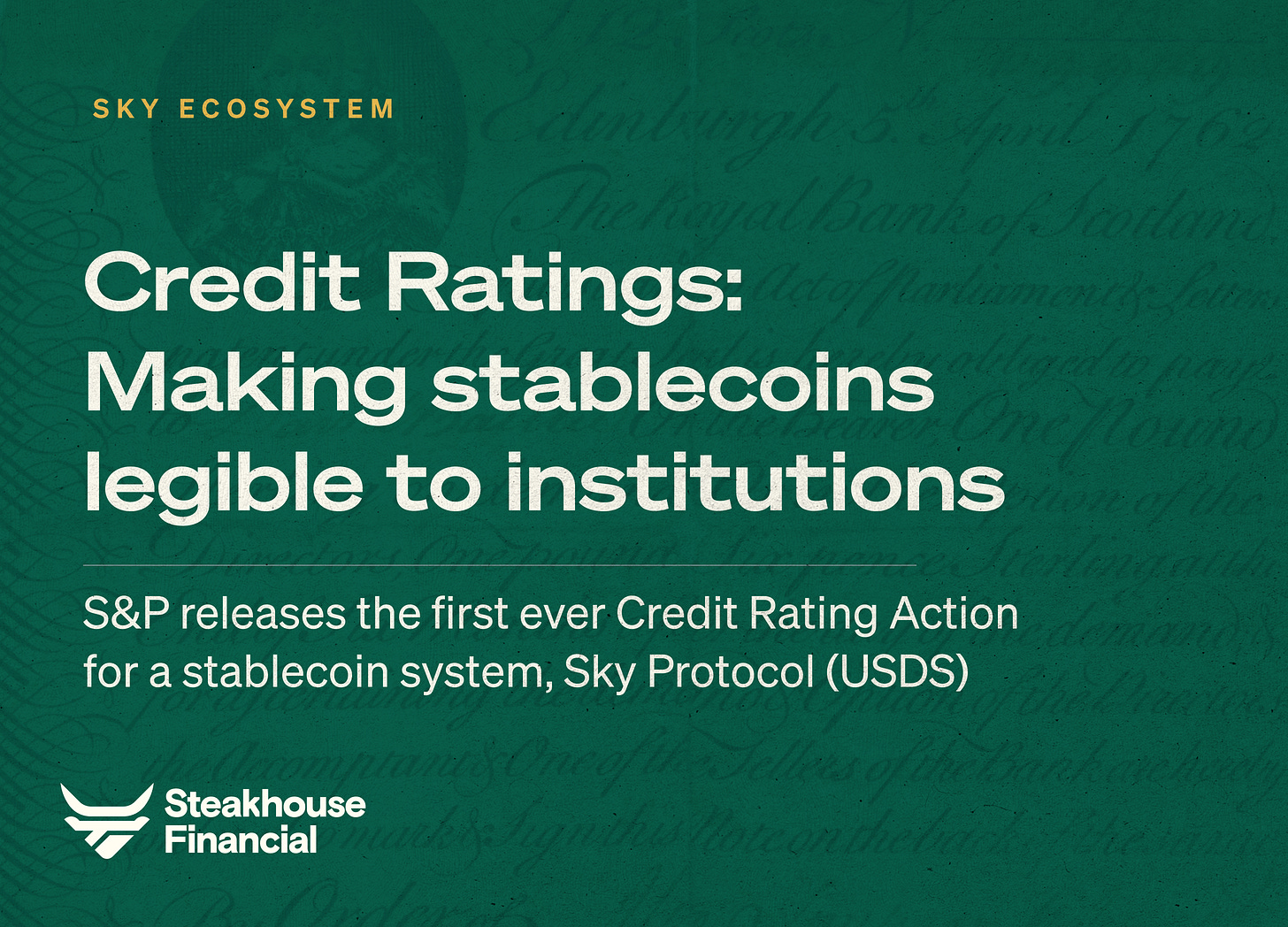Credit Ratings: Making Stablecoins Legible to Institutions
S&P releases the first ever Credit Rating Action for a stablecoin system, Sky Protocol (USDS)
For more on Sky and USDS: https://sky.money
For more on S&P’s Rating Action: https://www.spglobal.com/ratings/en/regulatory/article/-/view/type/HTML/id/3421145
In traditional financial markets, credit ratings reduce information asymmetry. They act as translation layers between assets and capital allocators. Credit ratings compress multidimensional signals into simple and comparable metrics. This compression reduces search costs, harmonizes filters and opens access to new sources of liquidity. Once an asset or an issuer receives a credit rating, they enter a global frame of reference, comparable to other asset classes. Simply put, credit ratings turn ‘products’ into usable ‘inputs’ for institutional portfolios.
Crypto offers transparency by design. Decentralized stablecoins in particular, such as Sky Protocol’s USDS, have the benefit of full transparency from how users behave with the stablecoin1, how the rules and parameters that regulate it are set2 and how the asset reserves are allocated34. However, this increase in information throughput also comes at a processing cost. More data and a lack of standardization makes immediate comparison and parsing difficult. In that sense, crypto protocols face similar challenges as any asset class: too much information and too little structure.
Stablecoins are widely recognized for their potential: instant settlement, reduced counterparty risk during transaction settlement and higher velocity of value. But adoption has lagged, especially at the institutional level, because of fragmentation and lack of standardization across issuers (aka lack of singleness5). MiCA in the EU and the GENIUS Act in the US are promising steps toward a harmonized legal framework, which is one way to try and help improve the quality of the market. But stablecoins today still feel like one-off custom tools, not standardized components of a broader financial ecosystem.
That’s what makes today’s announcement so important:
Today, S&P released the first ever credit rating for any stablecoin system and infrastructure (decentralized or otherwise), and we are proud that it is Sky Protocol, the largest decentralized stablecoin protocol, receiving that distinction (LINK).
Notably, this is an honest-to-goodness TradFi credit rating, unlike previous Stablecoin Stability Assessments released by S&P which do not constitute a ‘rating action’6.
While Sky Protocol is not a legal entity, and its architecture does not conform to traditional issuer frameworks, the protocol’s structure, its collateral reserves, smart contract mechanics, and systemic risk profile, were all evaluated by S&P Global Ratings under analytical methodologies typically used for nonbank financial institutions.
We are grateful to the S&P Digital Assets team for demonstrating an unusual level of sensitivity to the risks and benefits of a decentralized stablecoin model. Their framework gave us the opportunity to demonstrate that Sky’s decentralized mechanics are transparent and interpretable in a way that met the evaluative standards of a major ratings agency.
Our own risk sensitivities have been colored by years of experience in DeFi. We may instinctively view the credit risk of a DeFi wstETH loan (largely by virtue of its overcollateralization and liquidity) as preferable to some sovereign bonds. Clearly the S&P team is not there yet. But they showed a different perspective, explaining how traditional risk management models translate to a DeFi context, and offering useful pointers to how other industry participants (fiat-backed stablecoins, decentralized stablecoins and DeFi financial primitives in general) can take shape to really let the benefits of open and transparent finance bleed into the economy over time. We have always advocated this approach: incremental, taking the good without the bad from finance as we know it and demonstrating improvement in the areas DeFi can show a comparative advantage.
The initial rating, B- with outlook stable, is important in a few key regards:
Validates the ‘Endgame’ roadmap as a path towards an investment-grade rating (ranging from AAA to BBB);
Demonstrates that Sky’s transparency and mechanics are parseable and translatable for a traditional credit investment audience; and
Anchors USDS firmly in the traditional asset universe in its own right.
Looking ahead, Sky is now the first stablecoin to have a clear path towards an investment-grade credit rating that tracks the trajectory set out in the Atlas: increased transparency, increased token holder decentralization and iterative upgrades to continuously improve the analytics, collateral quality and reporting over time.
With this rating action, Sky Protocol can claim fame to be the first ever stablecoin issuer to cross the threshold. USDS is no longer just a product. It’s now an input, ready to be plugged into the machinery of global finance.
A Stablecoin Stability Assessment evaluates a stablecoin’s ability to maintain its peg under normal and stressed market conditions. It focuses on price stability, reserve composition, redemption mechanics, and operational transparency. It does not quantify the likelihood of default or loss to holders. It is an ad-hoc opinion issued at S&P’s discretion with no relation to Credit Ratings.
A Credit Rating, on the other hand, is a standardized measure of credit risk, specifically, the likelihood that an issuer or instrument will meet its financial obligations in full and on time. It translates risk into a numeric or letter grade that can be directly compared across asset classes.
From S&P: “An S&P Global Ratings credit rating is a forward-looking opinion of the capacity and willingness of an obligor to repay its financial obligations on time and in full. Our SSA is not a rating but a relative ranking on the forward-looking ability of a stablecoin to maintain its peg to a fiat currency or basket of fiat currencies. We have designed our assessment to offer market participants transparency regarding the stability of assessed stablecoins and to provide insights into their strengths and weaknesses.”




